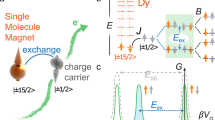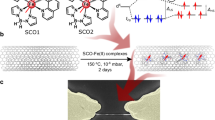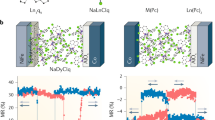Abstract
Magnetic molecules are potential building blocks for the design of spintronic devices1,2. Moreover, molecular materials enable the combination of bottom-up processing techniques, for example with conventional top-down nanofabrication3. The development of solid-state spintronic devices based on the giant magnetoresistance4, tunnel magnetoresistance5 and spin-valve effects6 has revolutionized magnetic memory applications. Recently, a significant improvement of the spin-relaxation time has been observed in organic semiconductor tunnel junctions7,8, single non-magnetic molecules coupled to magnetic electrodes have shown giant magnetoresistance9,10 and hybrid devices exploiting the quantum tunnelling properties of single-molecule magnets have been proposed2. Herein, we present an original spin-valve device in which a non-magnetic molecular quantum dot, made of a single-walled carbon nanotube contacted with non-magnetic electrodes, is laterally coupled through supramolecular interactions to TbPc2 single-molecule magnets (Pc=phthalocyanine). Their localized magnetic moments lead to a magnetic field dependence of the electrical transport through the single-walled carbon nanotube, resulting in magnetoresistance ratios up to 300% at temperatures less than 1 K. We thus demonstrate the functionality of a supramolecular spin valve without magnetic leads. Our results open up prospects of new spintronic devices with quantum properties.
This is a preview of subscription content, access via your institution
Access options
Subscribe to this journal
Receive 12 print issues and online access
$259.00 per year
only $21.58 per issue
Buy this article
- Purchase on Springer Link
- Instant access to full article PDF
Prices may be subject to local taxes which are calculated during checkout



Similar content being viewed by others
References
Rocha, A. R. et al. Towards molecular spintronics. Nature Mater. 4, 335–339 (2005).
Bogani, L. & Wernsdorfer, W. Molecular spintronics using single-molecule magnets. Nature Mater. 7, 179–186 (2008).
Lehn, J-M. Supramolecular chemistry: From molecular information toward self-organization and complex matter. Rep. Prog. Phys. 67, 249–265 (2004).
Baibich, M. N. et al. Giant magnetoresistance of (001)Fe/(001)Cr magnetic superlattices. Phys. Rev. Lett. 61, 2472–2475 (1988).
Binasch, G., Grünberg, P., Saurenbach, F. & Zinn, W. Enhanced magnetoresistance in Fe–Cr layered structures with antiferromagnetic interlayer exchange. Phys. Rev. B 39, 4828–4830 (1989).
Dieny, B. Giant magnetoresistive in soft ferromagnetic multilayers. Phys. Rev. B 43, 1297–1300 (1991).
Awschalom, D. D. & Flatté, M. M. Challenges for semiconductor spintronics. Nature Phys. 3, 153–159 (2007).
Dediu, V., Hueso, L., Bergenti, I. & Taliani, C. Spin routes in organic semiconductors. Nature Mater. 8, 707–716 (2009).
Brede, J. et al. Spin- and energy-dependent tunnelling through a single molecule with intramolecular spatial resolution. Phys. Rev. Lett. 105, 047204 (2010).
Schmaus, S. et al. Giant magnetoresistance through a single molecule. Nature Nanotech. 6, 185–189 (2011).
Sahoo, S. et al. Electric field control of spin transport. Nature Phys. 1, 99–102 (2005).
Aurich, H. et al. Permalloy-based carbon nanotube spin-valve. Appl. Phys. Lett. 97, 153116 (2010).
Hueso, L. et al. Transformation of spin information into large electrical signals using carbon nanotubes. Nature 445, 410–413 (2007).
Ishikawa, N. et al. Upward temperature shift of the intrinsic phase lag of the magnetization of bis(phthalocyaninato)terbium by ligand oxidation creating an S=1/2 spin. Inorg. Chem. 43, 5498–5500 (2004).
Stepanow, S. et al. Spin and orbital magnetic moment anisotropies of monodispersed bis(phthalocyaninato) terbium on a copper surface. J. Am. Chem. Soc. 132, 11900–11901 (2010).
Ishikawa, N., Sugita, M. & Wernsdorfer, W. Quantum tunnelling of magnetization in lanthanide single-molecule magnets: bis(phthalocyaninato)terbium and bis(phthalocyaninato)dysprosium anions. Angew. Chem. Int. Edn. 44, 2931–2935 (2005).
Christou, G., Gatteschi, D., Hendrickson, D. N. & Sessoli, R. Single-molecule magnets. MRS Bull. 25, 66–71 (2000).
Wernsdorfer, W. & Sessoli, R. Quantum phase interference and parity effects in magnetic molecular clusters. Science 284, 133–135 (1999).
Wernsdorfer, W. From micro- to nano-SQUIDs: Applications to nanomagnetism. Supercond. Sci. Technol. 22, 064013 (2009).
Ishikawa, N. et al. Determination of ligand-Field parameters and f electronic structures of double-decker bis(phthalocyaninato)lanthanide complexes. Inorg. Chem. 42, 2440–2446 (2003).
Zopellaro, G. et al. Spin dynamics in the negatively charged terbium (III) bis phthalocyaninato complex. J. Am. Chem. Soc. 131, 4387–4396 (2009).
Klyatskaya, S. et al. Anchoring of rare-earth-based single-molecule magnets on single-walled carbon nanotubes. J. Am. Chem. Soc. 131, 15143–15151 (2009).
Lopes, M. et al. Surface-enhanced Raman signal for terbium single-molecule magnets grafted on graphene. ACS Nano 4, 7531–7537 (2010).
Wang, Y. Y. et al. Single-walled carbon nanotube/cobalt phthalocyanine derivative hybrid material: Preparation, characterization and its gas sensing properties. J. Mater. Chem. 21, 3779–3787 (2011).
Hanson, R., Kouwenhoven, L. P., Petta, J. R., Tarucha, S. & Vandersypen, L. M. K. Spins in few-electron quantum dots. Rev. Mod. Phys. 79, 1217–1265 (2007).
Sapmaz, S., Jarillo-Herrero, P., Kouwenhoven, L. P. & van der Zant, H. S. J. Quantum dots in carbon nanotubes. Semicond. Sci. Technol. 21, S52–S63 (2006).
Otero, L. M., Caneschi, A. & Sessoli, R. X-Ray detected magnetic hysteresis of thermally evaporated terbium double-decker oriented films. Adv. Mater. 42, 5488–5493 (2010).
Katoh, K. et al. Direct observation of lanthanide(III)-phthalocyanine molecules on Au(111) by using scanning tunnelling microscopy and scanning tunnelling spectroscopy and thin-film field-effect transistor properties of Tb(III)- and Dy(III)-phthalocyanine molecules. J. Am. Chem. Soc. 131, 9967–9971 (2009).
Gopakumar, T. G., Müller, F. & Hietschold, M. STM and STS studies of planar and non-planar naphthalocyanines on graphite I & II. J. Phys. Chem. B 110, 6051–6060 (2006).
Vitali, L. et al. Electronic structure of surface-supported bis(phthalocyaninato) terbium(III) single molecular magnets. Nano Lett. 8, 3364–3368 (2008).
Acknowledgements
This work is partially supported by the DFG programmes SPP 1459 and TRR 88, ANR-PNANO project MolNanoSpin No ANR-08-NANO-002, ERC Advanced Grant MolNanoSpin No 226558, STEP MolSpinQIP and the Nanosciences Foundation of Grenoble. Samples were fabricated in the NANOFAB facility of the Néel Institute. We thank M. Affronte, F. Balestro, N. Bendiab, L. Bogani, E. Bonet, V. Bouchiat, L. Calvet, A. Candini, D. Feinberg, J. Jarvinen, L. Marty, T. Novotny, R. Piquerel, C. Thirion and R. Vincent for discussion and software development. We thank D. Lepoittevin, E. Eyraud, R. Haettel, C. Hoarau and V. Reita for technical support. We thank N-V. Nguyen and T. Crozes for help in device fabrication.
Author information
Authors and Affiliations
Contributions
M.U., M.R. and W.W. designed, carried out and analysed the experiments; J-P.C. helped to fabricate the devices; S.K. and M.R. designed, synthesized and characterized the molecule; M.U., M.R. and W.W. co-wrote the paper.
Corresponding authors
Ethics declarations
Competing interests
The authors declare no competing financial interests.
Supplementary information
Supplementary Information
Supplementary Information (PDF 1175 kb)
Rights and permissions
About this article
Cite this article
Urdampilleta, M., Klyatskaya, S., Cleuziou, JP. et al. Supramolecular spin valves. Nature Mater 10, 502–506 (2011). https://doi.org/10.1038/nmat3050
Received:
Accepted:
Published:
Issue Date:
DOI: https://doi.org/10.1038/nmat3050
This article is cited by
-
Ferromagnetism in sp2 carbon
Nano Research (2023)
-
Adsorption of lanthanide double-decker phthalocyanines on single-walled carbon nanotubes: structural changes and electronic properties as studied by density functional theory
Journal of Molecular Modeling (2023)
-
Approaching the uniaxiality of magnetic anisotropy in single-molecule magnets
Science China Chemistry (2023)
-
Exchange-induced spin polarization in a single magnetic molecule junction
Nature Communications (2022)
-
Magnetic molecules as local sensors of topological hysteresis of superconductors
Nature Communications (2022)



